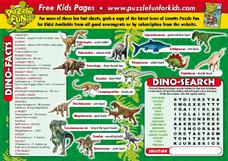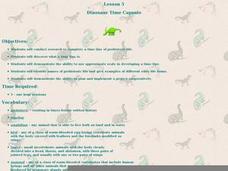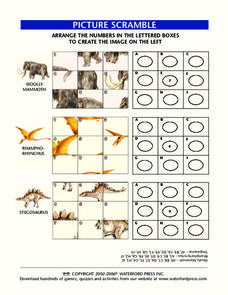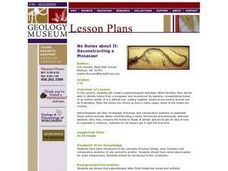Curated OER
Dino-facts
In this science worksheet, students investigate and compare 14 species of dinosaur by first reading about what their names mean. Students read 25 facts about these dinosaurs and complete a word search puzzle.
Curated OER
Dinosaur Time Capsule
Third graders research prehistoric life using educational software. They design a prehistoric life while showing the use of appropriate scale and names for the prehistoric life. They follow an internet link to participate in a virtual...
Desert Discoveries
Invent - A - Saurus
Fourth graders get to invent their own dinosaur! This is done by using a very clever worksheet embedded in the plan. The worksheet leads them through naming their dinosaur by having explanations of the Latin terminology that is used with...
Curated OER
Scientific Advances Could Bring Back the Dodo & Mammoth
Students reflect on the possibility of bringing extinct species back to life. In this ESL lesson plan, students debate the pros and cons of extinction reversal then complete several activities centered around the topic.
Curated OER
Earth Lesson Plans
Students gain understanding of how a fossil is formed and why they are so important. In this fossil lesson students create their own fossils.
Curated OER
Making Tracks
Fifth graders examine the fossil footprints of two and four legged dinosaurs. Using this information, they try to determine how the dinosaurs lived their lives. They use their own walking pattern to compare it to the dinosaurs and...
Curated OER
Picture Scramble
In this picture scramble worksheet, students place scrambled pieces of
a picture in the correct place to create a full picture of a woolly mammoth and two dinosaurs. There are nine scrambled pieces for each of the three puzzles.
Curated OER
Creating New Forms of Life
High schoolers are asked to use their imaginations to take the idea of biotechnology one step further. Before beginning this activity students read and complete a report on the book "Jurassic Park," which deals with the use of...
Curated OER
No bones About It -A Mosasaur
Students model a paleontologist's activities. They identify dinosaur bones and reassemble them into a skeleton of an extinct reptile.
Curated OER
Scientific Inquiry 3
In this lesson, 6th graders research and examine current theories behind the mass extinction of dinosaurs. After a discusion about the extinction of the dinosaurs, students discuss the two major extinction theories talked about in the...
Curated OER
The Lost World (4 parts)
Tenth graders view this science fiction adventure, though not scientifically accurate, creates opportunities to explore the extinction of dinosaurs and to explore evolution.
Curated OER
Birds
High schoolers study birds and examine the idea that they evolved from reptiles or dinosaurs. In this birds lesson students divide into groups and research one side of the debate, then at the end have the high schoolers debate each-other.
Curated OER
Relative Dating - Telling Time Using Fossils
Students use fossil range charts to explain relative dating. They graph for ammonites, marine organisms that went extinct at the same time as dinosaurs.
Curated OER
Investigation 3 - Examining Your Fossil
Fourth graders examine the fossils they made previously. They examine the details of the fossil with a hand lens and come up with conclusions about the fossils. They record what they see and draw conclusions about the environment of the...
Curated OER
Morphing
Pupils examine how organisms adapt to their environment in order to survive. As a class, they discuss the extinction of the dinosaurs and review Darwin's theory of survival of the fittest. They select an animal to morph in the future and...
Curated OER
Dig This
Fifth graders explore the work of paleontologists and the life of dinosaurs and create a sculpture of the bones of a Stegosaurus. The sculpture was then buried and used by other classes for a dig.
Curated OER
Diversity and Adaptations of Organisms
Eighth graders discover the difference between extinct and endangered animals and discuss the reasons why this has occured. They identify threatened and endangered animals living in their local area as well.
Curated OER
Make a Cast of a Tyrannosaurus rex Fossil
Second graders examine the formation of fossils and list the different types. They make cast model of a dinosaur fossil. They write about conditions that are necessary for fossils to form and create a model of a buried fossil.
Curated OER
Studying Fossils
Students hypothesize dinosaur size and speed by looking at dinosaur track way or by measuring a dinosaur models water displacement. In addition, techniques to help students become familiar with the ways paleontologists study fossils can...
Curated OER
Studying Fossils
Students study the Evolution in the Light of Fossils. Activities in this lesson range from quantitative measurements of hominoid skulls to the comparison of hominoid bone structures. They hypothesize dinosaur size and speed by looking at...
Curated OER
Why Care About Amphibian Population Decline and Malformations?
Students examine the reasons for preserving wildlife. They look at reasons for amphibian malformations and write an essay about the ethical issues that this brings up. They listen to the teacher read quotes about extinction and how the...
Curated OER
Eagles and Other Raptors
Students become familiar with basic facts and behavior of the American Bald Eagle using a combination of classroom presentation, Video, Internet searching, "hands on" computer activity, and touching of feathers and displays.
Curated OER
Relative Dating-Telling Time Using Fossils
Students explore how to read fossil range charts. They develop an knowledge of the strengths and weaknesses of the fossil record. Students become familiar with the concepts index fossil and fossil range. Students use bar graphs to...
Curated OER
Toilet Paper Geologic Time Scale
Learners examine and demonstrate the extent of geologic time compared to recent time. They develop a demonstration of geologic time using an unrolled roll of toilet paper, with each sheet of toilet paper representing 20 million years.

























